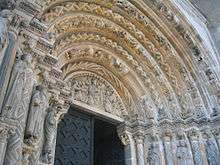Freiberg Cathedral

The Freiberg Cathedral or Cathedral of St Mary (German: Dom St. Marien) is a church of the Evangelical-Lutheran Church of Saxony in Freiberg in Saxony. The term Dom, a German synecdoche used for collegiate churches and cathedrals alike, is often uniformly translated as cathedral into English, even though this church here was a collegiate church, not a cathedral (seat of a bishop).
History
Around 1180, the basilica "of Our Lady" was built in Freiberg, which was developing rapidly due to the silver that had recently been found in the Ore Mountains. Two significant works of art that are still conserved were added very early: the Triumphkreuzgruppe crucifixion group (around 1225) and the Goldene Pforte (Golden Gate). In 1480, the church was turned into a Collegiate church, which earned the church the naming Dom, in German used for collegiate churches and cathedrals alike. However, the college was dissolved after only 57 years due to the reformation in the Electorate of Saxony.

In the great fire of 1484, the church was almost completely destroyed. However, the crucifixion group, golden gate, and parts of the quire were preserved. The Cathedral of St. Mary was built at the same location as a triple-naved Gothic hall church. A remarkable feature are the two adjacent pulpits in the central nave: the free-standing Tulpenkanzel (Tulip pulpit) from 1505, made by sculptor Master H.W. of a light type of the Tuff from Chemnitz-Hilbersdorf and the Bergmannkanzel (Miner's pulpit) of 1638 created by Hans Fritzsche of a Saxon sandstone.[1][2]
Interior

Between 1541 and August II the Strong's conversion to Catholicism, nine rulers of Saxony were buried in the quire of the cathedral. August's mother and her sister are buried in the sisters' crypt in the All Saints chapel. Their tomb, created by the Saxon Baroque sculptor Balthasar Permoser, had originally been situated in the Lichtenburgk Monastery at Prettin, but was moved to Freiberg in 1811. Another noteworthy feature is the monument honoring Maurice, Elector of Saxony, who also is buried in the Freiberg Cathedral.
Several monumental brasses form the floor of the quire. The walls are decorated with a wealth of epitaphs and sculptures of the ducal house. The design of the ceiling is a combination of painting and sculpture in the style of Italian mannerism. The transition between wall and ceiling is formed by a multitude of musical angels on the uppermost ledge of the epitaph architecture. Analysis has shown that the instruments used are real Renaissance instruments or excellent imitations. This was very useful, since no other instruments of this time were extant. These finds were examined in Leipzig, and replicas were built. Even the imitations were detailed enough to serve as a blueprint for replicas, and these instruments were relevant to allow the reproduction of the typical sound of an orchestra of the time.
A special attraction for organ enthusiasts is the great organ by Gottfried Silbermann with its three manuals, 44 organ stops and 2574 organ pipes. Opposite of it is another, smaller Silbermann organ, which is also an excellent instrument.
The cathedral has six church bells, four of which are from the famous Hilliger casting house. The heaviest of the bells is the Große Susanne at 5 tons.

The Golden Gate is a late Romanesque arched sandstone portal on the southern side of the cathedral, adorned by sculptures and richly ornamented columns that were originally richly colorated. To protect the gate from environmental influences, an extension was built in 1902/03.
The cathedral is still used for services by the congregation. It can be visited daily for a fee in guided tours.
External links
- (German)Congregation homepage
References
- This article is based on a translation of the German Wikipedia article Freiberger Dom.
- ↑ Georg Dehio: Handbuch der deutschen Kunstdenkmäler, Sachsen II. Deutscher Kunstverlag, München, Berlin 1998, p. 265 ISBN 3-422-03048-4
- ↑ Arndt Kiesewetter, Heiner Siedel, Michael Stuhr: Die Tulpenkanzel im Dom zu Freiberg. Arbeitsheft 2, Landesamt für Denkmalpflege Sachsen. Dresden 1995, S. 68-74 ISBN 3-87490-870-4
Coordinates: 50°55′13″N 13°20′36″E / 50.92028°N 13.34333°E